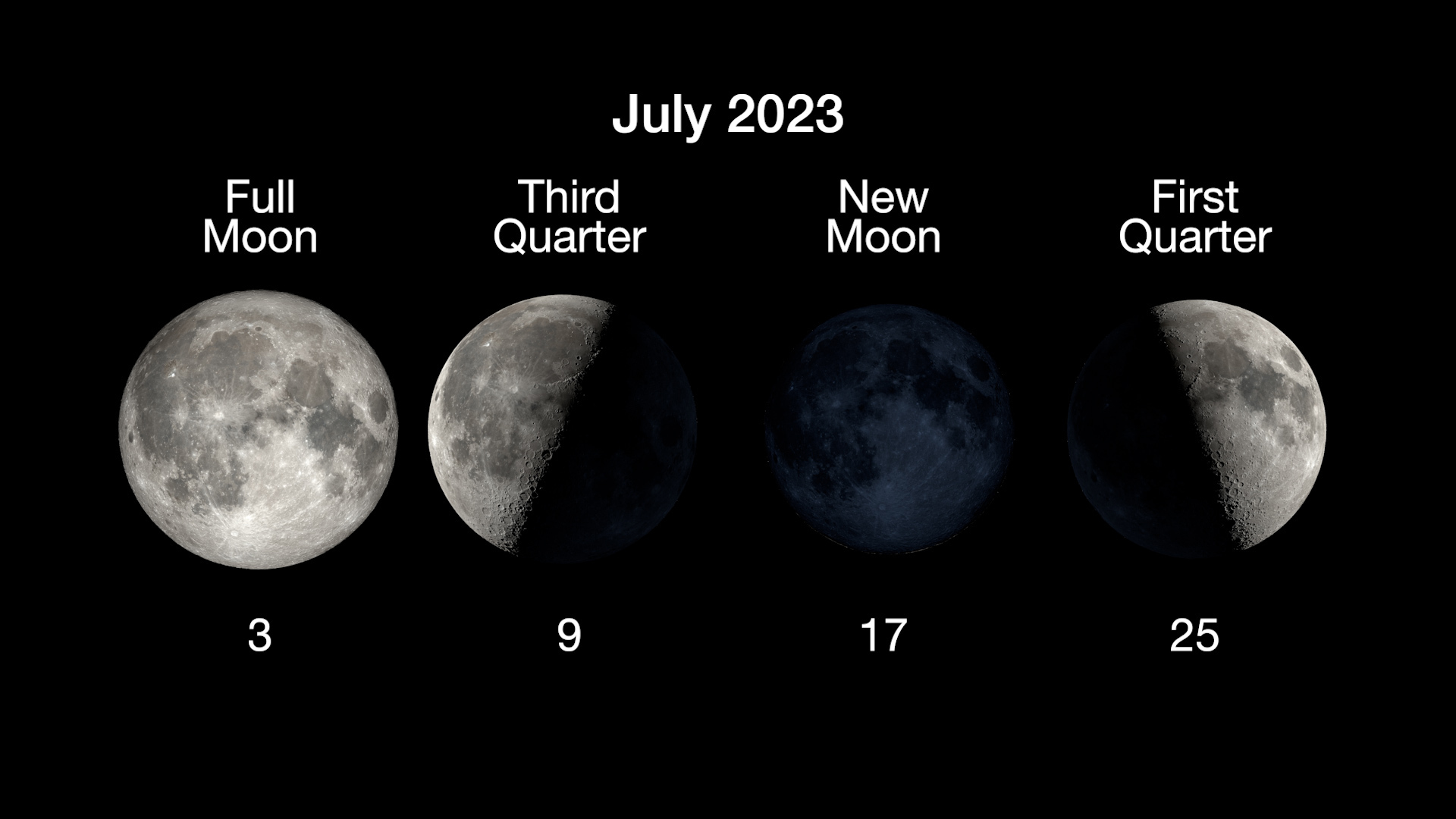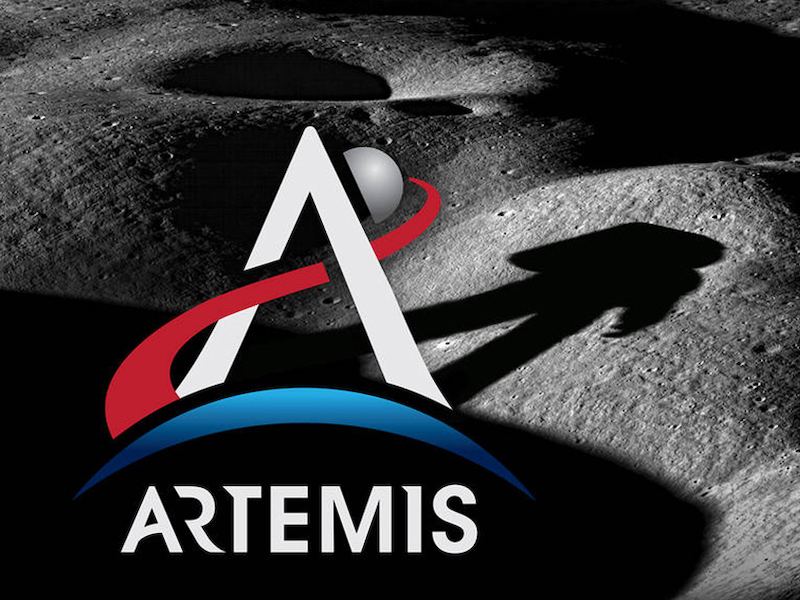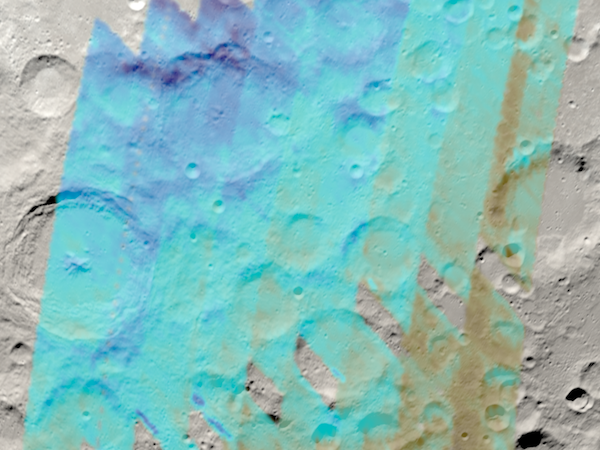News | June 22, 2023
The Next Full Moon is a Supermoon; the Buck or Thunder Moon

The phases of the Moon for July 2023. Credit: NASA/JPL-Caltech
The Next Full Moon is a Supermoon; the Buck or Thunder Moon; the Hay, Mead, or Rose Moon; Guru Purnima; and Asalha Puja or Dharma Day.
The next full Moon will be on Monday morning, July 3, 2023, appearing opposite the Sun in Earth-based longitude at 7:39 AM EDT. This will be late Sunday night in the International Date Line West time zone and early Tuesday morning from the Chatham Island Time zone eastward to the International Date Line. The Moon will appear full for 3 days around this time, from Saturday evening to Tuesday evening.
Many publications consider this the first of four consecutive supermoons in 2023. The term "supermoon" was coined by astrologer Richard Nolle in 1979 as either a new or full Moon that occurs when the Moon is within 90% of perigee, its closest approach to Earth. Since we can't see a new Moon (except when it passes in front of the Sun), what has caught the public's attention in recent decades are full supermoons, as these are the biggest and brightest full Moons for the year. Different publications use different thresholds for deciding which full Moons qualify as a supermoon. In 2023, some publications recognize four supermoons (this full Moon, the two full Moons in August, and the full Moon in September), while others recognize only the two brightest supermoons, the full Moons in August.
The Maine Farmers' Almanac began publishing "Indian" names for full Moons in the 1930s and these names are now widely known and used. According to this almanac, as the full Moon in June the Algonquin tribes of what is now the north-eastern United States called this the Buck Moon. Early summer is normally when the new antlers of buck deer push out of their foreheads in coatings of velvety fur. They also called this the Thunder Moon because of early Summer's frequent thunderstorms.
Europeans called this the Hay Moon for the haymaking in early summer, and sometimes the Mead Moon (although this name was also used for the previous full Moon). Mead is created by fermenting honey mixed with water, sometimes adding fruits, spices, grains, or hops.
Another European name for this full Moon is the Rose Moon, although this could also apply to the full Moon in June. Some sources indicate the name comes from the color of the full Moon when it is low in the sky. The orbit of the Moon around the Earth is almost in the same plane as the orbit of the Earth around the Sun (only about 5 degrees off). On the summer solstice the Sun appears highest in the sky for the year. Full Moons are opposite the Sun, so a full Moon near the summer solstice will be low in the sky. Particularly for Europe's higher latitudes, when the full Moon is low it shines through more atmosphere, making it more likely to have a reddish color (for the same reasons that sunrises and sunsets are red). For the Washington, DC area, this full Moon will be closer to the summer solstice and 2 degrees lower in the sky at its highest than the full Moon was in June. At 12:58 AM EDT on the morning of July 3, the full Moon at its highest will reach only 22.4 degrees above the southern horizon, two degrees lower than what the full Moon in June reached at its highest.
For Hindus, Buddhists and Jains, this is the Guru Full Moon (Guru Purnima), celebrated as a time for clearing the mind and honoring the guru or spiritual master.
For Theravada Buddhists this full Moon is Asalha Puja, also known as Dharma Day or Esala Poya, an important festival celebrating the Buddha's first sermon after reaching nirvana, which started Buddhism. This sermon became the core of Buddhist teachings and includes the four noble truths.In addition, with this full Moon the Buddhist Monks start Vassa, thannual three-month retreat du ring the rainy season.
In many traditional lunisolar and lunar calendars full Moons fall on or near the middle of the lunar months. This full Moon is in the middle of the fifth month of the Chinese calendar, Tammuz in the Hebrew calendar, and Dhu al-Hijjah, the tFboowelfth and final month of the Islamic year. Dhu al-Hijjah is the month of the Hajj (the pilgrimage to Mecca) and Eid al-Adha (the Feast of the Sacrifice), a multi-day festival ending just before this full Moon. Eid al-Adha is the second-most important Islamic festival (after Eid at-Fitr at the end of Ramadan). Dhu al-Hijjah is one of four sacred months during which fighting is forbidden.
Since this is the Thunder Moon, a quick note on lightning safety. Most of the lightning that strikes the ground arcs from the negatively charged bottom of the storm to the ground underneath the storm. Much rarer is positive lightning, which arcs from the top of a thunderstorm to strike the ground up to eight miles away. Positive lightning can sometimes strike areas where the sky is clear (hence the term "bolt out of the blue"). Because it arcs across a greater distance it tends to be 5 to 10 times more powerful than regular ground strikes. Because it can strike dry areas outside of the storm, positive lightning tends to start more fires than negative lightning. Although positive lightning is rare (less than 5% of all lightning strikes), the lack of warning and its greater power make it more lethal. A good rule to follow is, if you can hear the thunder, you can be struck by lightning. As a former bicycle commuter (before I retired from NASA), I am well aware that the inch or so of rubber tire between my metal bicycle and the ground will make little difference to a bolt that can arc across miles of air from the top of a thunderstorm to where I am riding.
As usual, the wearing of suitably celebratory celestial attire is encouraged in honor of the full Moon. Be safe (especially during thunderstorms), avoid starting wars, and take a moment to clear your mind.
As for other celestial events between now and the full Moon after next (with specific times and angles based on the location of NASA Headquarters in Washington, DC):
As summer continues the daily periods of sunlight continue to shorten. On Monday, July 3, 2023 (the day of the full Moon), morning twilight will begin at 4:36 AM, sunrise will be at 5:47 AM, solar noon will be at 1:12 PM when the Sun will reach its maximum altitude of 74.1 degrees, sunset will be at 8:37 PM, and evening twilight will end at 9:49 PM. By Tuesday, August 1 (the day of the full Moon after next), morning twilight will begin at 5:03 AM, sunrise will be at 6:09 AM, solar noon will be at 1:14 PM when the Sun will reach its maximum altitude of 69.1 degrees, sunset will be at 8:19 PM, and evening twilight will end at 9:25 PM.
Meteor viewing opportunities during this lunar cycle are predicted to be limited. Four meteor showers [the July Pegasids (175 JPE), the Piscis Austrinids (183 PAU), the July Gamma-Draconids (184 GDR), and the Alpha-Capricornids (001 CAP)] are expected to peak at only about 5 visible meteors per hour under ideal conditions (far from city lights, etc.). The Southern Delta-Aquariids (005 SDA) could produce more visible meteors, but this shower is better seen from the southern hemisphere and moonlight will interfere this year.
Evening Sky Highlights
On the evening of Monday, July 3, 2023 (the night of the full Moon), as evening twilight ends (at 9:49 PM EDT), the rising full Moon will be 3 degrees above the southeastern horizon. Two of the five visible planets will be in the sky, bright Venus (as the evening star) at 11 degrees, and Mars at 14 degrees above the western horizon. The bright star appearing closest to overhead will be Arcturus, the brightest star in the constellation Boötes the herdsman or plowman, at 65 degrees above the southwestern horizon. Arcturus is the 4th brightest star in our night sky and is 36.7 light years from us. While it has about the same mass as our Sun, it is about 2.6 billion years older and has used up its core hydrogen, becoming a red giant 25 times the size and 170 times the brightness of our Sun.
As this lunar cycle progresses, bright Venus, Mars, and the background of stars will appear to shift westward each evening (as the Earth moves around the Sun), with Mars shifting more slowly. Sometime after July 6, Mercury will join these planets in the glow of dusk, but will not start appearing above the horizon as evening twilight ends until July 23. Venus will reach its brightest on July 7. Mars and Regulus will be less than a degree apart on July 10. Between July 18 and 21 the waxing Moon will appear to move along the line of Mercury, Venus, Regulus, and Mars. July 21 will be the last evening Venus will be above the horizon as twilight ends. The Moon will appear near Spica on July 24 and Antares on July 28. Also on July 28 Mercury will appear quite close to Regulus low on the horizon, setting a few minutes after twilight ends.
By the evening of Tuesday, August 1, (the night of the full Moon after next), as evening twilight ends (at 9:25 PM EDT), the rising full Moon will be 5 degrees above the southeastern horizon. Two of the five visible planets will be in the sky, bright Mercury just 1/2 degree above the west-northwestern horizon and Mars at 5 degrees above the western horizon. The bright star appearing closest to overhead will be Vega, the brightest star in the constellation Lyra the lyre, at 71 degrees above the eastern horizon. Vega is one of the three bright stars in the Summer Triangle (along with Deneb and Altair). Vega is the 5th brightest star in our night sky, about 25 light-years from Earth, has twice the mass of our Sun, and shines 40 times brighter than our Sun.
Morning Sky Highlights
On the morning of Monday, July 3, 2023, (the morning before the full Moon after next), as morning twilight begins (at 4:36 AM EDT), the setting full Moon will be 6 degrees above the southwestern horizon. Two of the visible planets will be in the sky, bright Jupiter at 28 degrees above the eastern horizon and Saturn at 40 degrees above the southern horizon. The bright star appearing closest to overhead will be Deneb at 72 degrees above the west-northwestern horizon. Deneb is the brightest star in the constellation Cygnus the swan and is one of the three bright stars in the Summer Triangle (along with Vega and Altair). Deneb is about 20 times more massive than our Sun but has used up its hydrogen, becoming a blue-white supergiant about 200 times the diameter of the Sun. If Deneb were where our Sun is, it would extend to about the orbit of the Earth. Deneb is about 2,600 light years from us and is the 19th brightest star in our night sky.
As this lunar cycle progresses, Jupiter, Saturn, and the background of stars will appear to shift westward each evening. The waning Moon will appear near Saturn on July 7, Jupiter on July 11, and the Pleiades star cluster on July 13. By the morning of Tuesday, August 1, (the morning of the full Moon after next), as morning twilight begins (at 5:03 AM EDT), the setting full Moon will be 4 degrees above the southwestern horizon. Two of the visible planets will be in the sky, bright Jupiter at 52 degrees above the east-southeastern horizon and Saturn at 33 degrees above the southwestern horizon. At 52 degrees Jupiter will also be the bright object closest to overhead.
Detailed Daily Guide
Here for your reference is a day-by-day listing of celestial events between now and the full Moon after next. The times and angles are based on the location of NASA Headquarters in Washington, DC, so some of these details may differ for your location (I use parentheses to indicate specific times that might be different for you).
For the Washington, DC area and similar latitudes, at least (I have not checked other latitudes), Wednesday, June 28, 2023, will be the day with the latest sunset of the year (with sunset at 8:37:30 EDT). Our clocks use the average length of a solar day, but solar days are longer near the solstices and shorter near the equinoxes. Because of this, the earliest sunrise of the year occurs before the summer solstice and the latest sunset of the year occurs after the solstice.
On Saturday morning, July 1, 2023, the planet Mercury will be passing on the far side of the Sun as seen from Earth, called superior conjunction. Because Mercury orbits inside of the orbit of Earth it will be shifting from the morning to the evening sky and will begin emerging from the glow of dusk on the western horizon sometime after July 6 (depending upon viewing conditions).
In the evenings of late June and early July, 2023, the bright planet Venus and the planet Mars will appear near each other in the western sky, forming a line with the bright star Regulus. Friday evening, June 30, will be when Venus and Mars will be at their closest. As evening twilight ends (at 9:50 PM EDT) Venus will be 13 degrees above the western horizon with Mars 3.6 degrees to the upper left and Regulus farther to the upper left. Venus will set first on the west-northwestern horizon 72 minutes later (at 11:02 PM).
Friday evening into early Saturday morning, June 30 to July 1, 2023, the bright star Antares will appear near the waxing gibbous Moon. The Moon will be 25 degrees above the south-southeastern horizon as evening twilight ends (at 9:50 PM EDT) with Antares 4 degrees to the lower left. The Moon will shift closer to Antares as the night progresses. The Moon will reach its highest in the sky for the night 1 hour later (at 10:51 PM). By the time Antares sets on the southwestern horizon Saturday morning (at 3:31 AM) Antares will only be one degree to the left of the Moon.
As mentioned above, the next full Moon will be Monday morning, July 3, 2023, at 7:39 AM EDT. Because the Moon will be at perigee about 1.5 days later, some publications consider this to be the first of four supermoons. The Moon will appear full for 3 days around this time, from Saturday evening to Tuesday evening.
Tuesday afternoon, July 4, 2023, at 6:26 PM EDT, the Moon will be at perigee, its closest to the Earth for this orbit.
Thursday afternoon, July 6, 2023, at 4:06 PM EDT, the Earth will be at aphelion, its farthest away from the Sun in its orbit, 3.4% farther away than it was at perihelion in early January. Since the intensity of light drops off as the square of the distance, the sunlight reaching the Earth at aphelion is about 6.5% less bright than sunlight reaching the Earth at perihelion.
Thursday evening, July 6, 2023, will be the first evening that the planet Mercury will be above the west-northwestern horizon 30 minutes after sunset, a rough approximation of when it might first be visible in the glow of dusk.
Thursday night into Friday morning, July 6 to 7, 2023, the planet Saturn will appear near the waning gibbous Moon. As the Moon rises above the east-southeastern horizon (at 11:31 PM EDT) Saturn will be less than 4 degrees to the upper left. As the night progresses Saturn will swing clockwise around the Moon, appearing 4 degrees to the upper right of the Moon by the time morning twilight begins (at 4:38 AM).
Friday evening, July 7, 2023, Venus as the evening star will reach its brightest for this apparition, appearing as a crescent through a telescope. As evening twilight ends (at 9:47 PM EDT) Venus will be 9 degrees above the western horizon, with the planet Mars and the bright star Regulus to the upper left. Venus will set on the west-northwestern horizon 50 minutes later (at 10:37 PM). After July 7, Venus will fade and shift closer to the horizon each night until it passes between the Earth and the Sun in mid August.
Sunday evening, July 9, 2023, the waning Moon will appear half-full as it reaches its last quarter at 9:48 PM EDT.
Monday evening, July 10, 2023, will be when the planet Mars and the bright star Regulus will appear nearest each other, just 2/3 of a degree apart. As evening twilight ends (at 9:46 PM EDT), Regulus will be 11 degrees above the western horizon with Mars to the upper right. Mars will be slightly fainter than Regulus, as Mars is shifting farther away from Earth and will be passing around the far side of the Sun in mid November. The bright planet Venus will be to the lower right of the pair. Regulus will set an hour later (at 10:45 PM).
Tuesday morning, July 11, 2023, the planet Jupiter will appear about 8 degrees to the lower left of the waning crescent Moon. Jupiter will rise on the east-northeastern horizon (at 1:39 AM EDT) a little more than 3 hours before morning twilight begins (at 4:41 AM).
By Wednesday morning, July 12, 2023, the waning crescent Moon will have shifted to the other side of Jupiter, with Jupiter about 7 degrees to the upper right of the Moon. The Moon will rise on the east-northeastern horizon (at 1:42 AM EDT) about 3 hours before morning twilight begins (at 4:42 AM).
Thursday morning, July 13, 2023, the Pleiades star cluster will appear about 3 degrees to the upper left of the waning crescent Moon. The Moon will rise on the east-northeastern horizon (at 2:14 AM EDT) about 2.5 hours before morning twilight will begin (at 4:43 AM).
Friday evening, July 14, 2023, the planet Mercury will appear near the Beehive cluster, but unless your viewing conditions are idea, I expect this will be difficult to see even with binoculars or a telescope, as the stars in this cluster are relatively faint and will set about 15 minutes before evening twilight ends.
Monday afternoon July 17, 2023, at 2:32 PM EDT, will be the new Moon, when the Moon passes between the Earth and the Sun and will not be visible from the Earth. The day of or the day after the New Moon marks the start of the new month for most lunisolar calendars. The sixth month of the Chinese calendar starts on Tuesday, July 18. Sundown on Tuesday, July 18, marks the start of Av in the Hebrew calendar.
In the Islamic calendar the months traditionally start with the first sighting of the waxing crescent Moon. Many Muslim communities now follow the Umm al-Qura Calendar of Saudi Arabia, which uses astronomical calculations to start months in a more predictable way. Using this calendar, sundown on Tuesday evening, July 18, 2023, will probably mark Al-Hijra, the Islamic New Year and the beginning of the month of Muharram (although Muharram is one of four months for which the calendar dates may be adjusted by the religious authorities of Saudi Arabia after actual sightings of the lunar crescent). Al-Hijra is a public holiday in many Muslim countries. Customs vary, but most include observing the day quietly and practicing gratitude. Muharram is one of the four sacred months during which warfare is forbidden.
Tuesday evening, July 18, 2023, if you have a clear view of the west-northwestern horizon, you might be able to see the thin, waxing crescent Moon with the planet Mercury 5 degrees to the left. At 30 minutes after sunset (9:01 PM EDT) the pair will be 5 degrees above the horizon. Mercury will set first 34 minutes later (at 9:35 PM), 5 minutes before evening twilight ends (at 9:40 PM). Venus, the bright star Regulus, and Mars will be farther to the upper left.
Wednesday evening, July 19, 2023, the waxing crescent Moon will have shifted to appear about 7 degrees to the upper left of Mercury, with Venus, the bright star Regulus, and Mars farther to the left. Mercury will set first on the west-northwestern horizon (at 9:36 PM EDT) 3 minutes before evening twilight ends (at 9:39 PM).
Thursday, July 20, 2023, is International Moon Day and the anniversary of the Apollo 11 landing, the first human landing on the Moon. See https://www.un.org/en/observances/moon-day for more information. As someone who worked on the Viking Mission, I like to mention that it is also the anniversary of the first fully successful robotic landing on Mars by the Viking 1 lander (5 years earlier the Soviet Mars 3 descent module landed successfully but stopped working after 20 seconds).
Thursday morning, July 20, 2023, at 2:57 AM EDT, the Moon will be at apogee, its farthest from the Earth for this orbit.
Thursday evening, July 20, 2023, the waxing crescent Moon will form a triangle with the planet Mars and the bright star Regulus. Mars will be 4 degrees to the left of the Moon and Regulus 5 degrees below the Moon. The bright planet Venus will be farther below Regulus and Mercury will appear to the lower right. Mercury will set first on the west-northwestern horizon (at 9:36 PM EDT) just 2 minutes before evening twilight ends (at 9:38 PM). Venus will set 7 minutes after evening twilight ends (at 9:45 PM), Regulus will set 20 minutes after that (at 10:05 PM), Mars 19 minutes after Regulus (at 10:24 PM), and the Moon 6 minutes after Mars (at 10:30 PM).
Friday evening, July 21, 2023, the waxing crescent Moon will have shifted to the upper left, forming a line from the Moon (on the upper left), to Mars, then Regulus, then Mercury (on the lower right), with bright Venus below Regulus. Mercury will set on the west-northwestern horizon around the same time as evening twilight ends (at 9:37 PM EDT). Venus will set 3 minutes later (at 9:40 PM). This will be the last evening that Venus will be above the horizon as evening twilight ends.
Sunday evening, July 23, 2023, will be the first evening that the planet Mercury will be above the horizon as evening twilight ends (at 9:36 PM EDT), setting one minute later (at 9:37 PM).
Monday night, July 24, 2023, the bright star Spica will appear near the waxing crescent Moon. Spica will be 3 degrees to the left of the Moon as evening twilight ends (at 9:34 PM EDT). The pair will shift closer together until Spica sets about 2 hours later (at 11:50 PM)
On Tuesday afternoon, July 25, 2023, the Moon will appear half-full as it reaches its first quarter at 6:07 PM EDT.
Friday evening, July 28, 2023, very low on the west-northwestern horizon, the bright star Regulus will appear just 0.14 degrees to the upper right of the planet Mercury. As evening twilight ends (at 9:30 PM EDT) the pair only be 0.5 degrees above the horizon and they will set 4 minutes later. Mars will appear to the upper left of the pair.
Also on Friday night into Saturday morning, July 28 to 29, 2023, the bright star Antares will appear to the right of the waxing gibbous Moon. The Moon will be 24 degrees above the southern horizon as evening twilight ends (at 9:30 PM EDT) with Antares about 5 degrees to the right. Antares will set first on the southwestern horizon a little more than 4 hours later (at 1:41 AM).
The full Moon after next will be Tuesday afternoon, August 1, 2023, at 2:32 PM EDT. This will be on Wednesday morning from the India Standard Time zone eastward to the International Dateline. The Moon will appear full for 3 days around this time, from early Monday morning into early Thursday morning.






